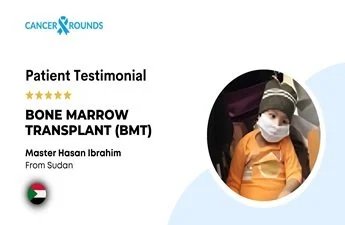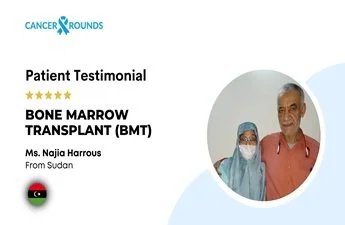Aplastic Anemia Treatment Cost
What is Aplastic Anemia?
The term aplastic anemia refers to the condition in which the body stops forming new blood cells. Due to fewer blood cells, the patient feels fatigued and there is a high risk of infections and unrestrained bleeding in some cases. Bone marrow transplant is widely used to treat aplastic anemia in the world, but apart from that, there are several methods to treat aplastic anemia.
The type of treatment depends upon some factors such as age, overall health, and severity of the condition.
Common Symptoms of Aplastic Anemia
There are a few common symptoms of aplastic anemia which include
- Weakness
- Fatigue
- Dizziness
- Irregular heartbeat
- Frequent infections
- Shortness of breath
- Unexplained bruising
These are some of the early symptoms of aplastic anemia which can indicate a patient about their condition.
The symptoms may get worse with increasing adversity of aplastic anemia.
Diagnosis of Aplastic Anemia
There are several ways to diagnose blood cancer but for aplastic anemia, bone marrow biopsy is considered to be the best way of diagnosis. Let us discuss what happens in bone marrow biopsy.
- Bone marrow biopsy is a procedure recommended by the doctor to find out the level of blood cells in a patient’s body which in turn determines the presence of aplastic anemia in the patient’s body.
- In this process, a small sample of bone marrow is removed from a large bone which is then examined to find out the presence of aplastic anemia.
- In this condition, bone marrow contains fewer blood cells than the normal level of the three blood cells i.e. red blood cells, white blood cells, and blood platelets.
Once the disease present in a patient’s body is confirmed as aplastic anemia, the patients need to go for additional tests and treatment procedures. Doctors need to figure out the cause of aplastic anemia in your body only then it can be treated and finally cured.
If your doctor can identify the reason for the occurrence of aplastic anemia in your body and get rid of that trigger, aplastic anemia can be treated efficiently and the condition may go away.
Treatment afterward:
- The best hematologist may prescribe hormone tests and drugs to help your blood count reach a normal level.
- The treatment procedures also include transfusion medicine which manages the transfusion process of blood products and makes it happen in a smooth way without any obstacles and potential complications.
Aplastic Anemia Treatment Cost
Aplastic anemia is a serious and rare condition in which the body stops producing enough new blood cells.
This condition is also known as bone marrow aplasia which develops as a result of bone marrow damage.
Depending upon the type of treatment, the aplastic anemia treatment cost ranges between USD 9000 (6,00,000 INR) to USD 30000 (21.00.000 INR).
| City | Cost of Aplastic Anemia Treatment in INR |
| Delhi | Rs. 6,00,000 – Rs. 18,00,000 |
| Mumbai | Rs. 10,00,000 – Rs. 20,00,000 |
| Bangalore | Rs. 9,00,000 – Rs. 18,00,000 |
| Chennai | Rs. 8,00,000 – Rs. 20,00,000 |
The various treatments include blood transfusions, bone marrow transplantation, and antibiotics or drug therapy. The price of the treatment depends on the treatment option and the severity of the condition. The cost involves a lot of factors such as blood transfusion, cost incurred in drugs given for treatment, and also the type of hospital room selected.
Aplastic anemia treatment cost can be reduced by requesting the hospital for discounted medicines as there are many biosimilar drugs available in India. This reduces the overall treatment cost for the patient with good-quality results. Depending upon the best possible treatment option for the patient, the doctors decide between ATG therapy, Bone Marrow Transplantation, or some other modern medicines to extend the life cycle of the patient.
Costs of Aplastic Anemia Treatment in Different Countries
Different countries have different costs of treatment for aplastic anemia. Some of the countries are listed below:
| Country | Cost of Treatment | Cost in USD |
| India | Rs. 6,00,000 – Rs. 20,00,000 | $7,500 – $25,000 |
| USA | $29,000 – $30,000 | $29,000 – $30,000 |
| Nigeria | ₦ 18,000,000 – ₦ 19, 620,000 | $42,300 – $46,000 |
India is the most affordable country to get treatment for aplastic anemia.
India only provides the best facilities, but it also offers these facilities at the lowest price in the world.
Factors that Affect Aplastic Anemia Treatment cost
Several factors can affect the cost of treatment for aplastic anemia, some of them are listed below:
- Diagnostic tests
- Main course of treatment
- Medicines
- Consultation fee
- Hospital stay
Other than these factors, there could be some other variables as well, which could affect the cost of treatment.
Related Doctors
Need More Recommendations ?
Aplastic Anemia Treatment
As mentioned in the very beginning the treatment for this condition depends on the severity of the condition. To diagnose aplastic anemia your doctor may ask you to go for blood tests
Blood tests will help a person to find out the levels of red blood cells, white blood cells, and blood platelets.
Usually, a low level of three of these blood cells i.e. the white blood cells, red blood cells, and blood platelets can determine the presence of aplastic anemia in your body.
If a patient is suffering from a severe case of aplastic anemia he/she will require going for a blood transfusion at a point in time.
In case the blood count is really low the doctor will suggest the patient go for a bone marrow transplant for which the patient will require a donor whose blood is a close match.
This procedure though a bit risky can be a permanent cure for aplastic anemia. This procedure is often practiced on younger people.
Even if a transplant is not an option the doctor may ask the patient to try and stop the body from attacking the patient’s bone marrow.
The condition may be curable by a hematologist depending upon the severity and the stage of aplastic anemia.
Fewer than 100 thousand cases per year this condition requires a medical diagnosis.
Before you go for any of the treatments mentioned above you must have a thorough conversation with your doctor and know about the respective risks of the various procedures.
Given below are the procedures which are usually suggested by the doctor to treat aplastic anemia:
1. Blood Transfusions
Aplastic anemia treatment usually involves blood transfusions to control the bleeding that occurs during the condition. This procedure does not offer a permanent cure to the condition but definitely relieves signs and symptoms by providing blood cells that your bone marrow isn’t producing. The procedure i.e. the transfusion increases the level of red blood cells and helps to temporarily cure fatigue and anemia and the transfusion of blood platelets helps to prevent excessive bleeding which occurs during the bleeding.
2. Bone Marrow Transplant
A bone marrow transplant is a part of aplastic anemia treatment. This procedure helps to rebuild the bone marrow with stem cells from donors. This treatment is often done in severe cases of aplastic anemia. The treatment is often recommended to younger people who have a matching donor most often a sibling. The treatment is a long process and the patient needs to pay frequent visits to the hospital and stay in the hospital for quite a long time.
In this treatment, it is often difficult to find a matching donor and the procedure carries its own risks. In this procedure, healthy cells from the donor are filtered from the blood. The healthy blood cells are then injected into the patient’s bloodstream, where they migrate to the bone marrow cavities to produce new blood cells. Even, the bone marrow transplant cost in India is low compared to other countries
3. ATG Therapy
Anti-thymocyte globulin or ATG is a drug made by antibodies that work as an immune system suppressor. Aplastic anemia is a health disorder where bone marrow is incapable of making new blood cells, resulting in the lowering of RBCs, s in the body. Immunosuppressive drug therapy is the treatment procedure for aplastic anemia patients whose bone marrow cells are mismatched with the donor.
Anti-thymocyte globulin ATG Therapy is applied to reduce the chance of organ rejection in organ transplantation.
- Use of ATG therapy in aplastic anemia
ATG therapy is an immunosuppressor therapy, which destroys specifically the T- lymphocytes in the body of the patient. T-lymphocytes are the white blood cells that kill the bone marrow stem cells in the patient having aplastic anemia. Hence it leads to low blood count. ATG therapy works on the principle of killing these T-lymphocytes and helps the bone marrow cells to make normal blood cells.
Eventually, increasing the blood count in the body of the patient and helping treat aplastic anemia.
- Effect of ATG therapy
ATG Therapy is given to the patient every 12 hours for days after bone marrow transplantation. ATG kills the T-Lymphocytic cell that attacks stem cells in the case of aplastic anemia. Anti-thymocyte globulin helps to regain bone marrow cells, and blood counts in case of aplastic anemia. ATG has the ability to enhance the blood count, which can stop the need for blood transfusion within a few months. It takes around 8-9 months to reach the average level in most cases.
ATG is an effective treatment for aplastic anemia done in the hospital, and it takes two weeks to complete. ATG therapy is avoided in case of low hemoglobin and platelet in the bloodstream. In these cases, platelet transfusion is done before starting ATG. ATG is a slow-releasing drug as it takes 12-18 hours to begin its effect.
- ATG therapy cost
The cost of ATG therapy varies a lot depending on the weight of the patient. The amount of dose that must be given to a patient depends on the weight of the patient and hence the cost will vary accordingly. The cost increases with the patient’s weight. Normally, the cost of ATG therapy ranges from Rs. 80,000 to Rs. 6,00,000 in India.
Other Important Information
- Other treatments for this condition include bone marrow stimulants, antibiotics, and antivirals. This condition makes the immune system weak making the patient prone to various other diseases and infections and frequent fevers. If not taken with proper care and medication the infections caused due to aplastic anemia may get worse.
- To prevent these infections and give relief to the patients the doctor may give antibiotics or antiviral medications to help prevent infections to get worse and make the patient’s condition better and less painful.
- Aplastic anemia which is caused due to radiation and chemotherapy treatments for cancer usually improves once the patient completes those treatments. Apart from treatments, a patient suffering from aplastic anemia must also take enough rest as this condition tends to make a person weak.
- Maintain personal hygiene and try to stay in a clean environment as much as possible this protects the patient from germs and reduces the risks of infection. Regular visits to the doctor are also important.
- The treatments which are done are safe and the patients tend to recover. Some of the immediate side effects of treatments that are quite common are nausea and a tendency to puke, fatigue, mouth sores, and diarrhea.
- The patients may not worry about these symptoms as they are quite common and natural as your body undergoes major treatment and thus, reacts to it. A patient diagnosed with aplastic anemia need to listen to the doctor follow a strict diet and maintain the utmost hygiene.
- To prevent frequent fevers and infections which occur during aplastic anemia a patient needs to get adequate sleep and avoid injuries. To prevent the increasing heart rate a patient avoids a visit to higher altitude areas and in general avoids traveling.
- The survival rate of people suffering from aplastic anemia is 80 percent for patients younger than age 20 who have a stem cell/ bone marrow transplant.
- Lack of proper treatment for this condition can be fatal and can cause serious infections. Proper treatment includes medicines to suppress your immune system to prevent serious medical conditions. Contact our team at Cancer Rounds for further details.
Side Effects of Treatment of Aplastic Anemia
Typically, these side effects of any type of treatment are minute and do not last for more than a few weeks after treatment.
Immunosuppressive drugs can cause temporary redness and itching skin. Whereas bone marrow graft rejection is rarely seen in any patients.
If a patient experiences any severe complications after treatment, they should contact the doctor and get appropriate treatment.
Survival Rate of Aplastic Anemia
Aplastic anemia is a fatal disease that affects the blood cells of a patient.
The survival rate of aplastic anemia, if diagnosed and treated at an early stage, is around 80% for a patient under the age of 20.
The overall survival rate of aplastic anemia is much higher for children as compared to adults.
But if diagnosed at an early stage it is very much possible to cure aplastic anemia in an adult as well.
Treatment is the second step; early diagnosis is the main factor in determining the survival of a patient.
Post-operative Precautions for Aplastic Anemia
The drugs that are prescribed during and after the main treatment may weaken the immune system of a patient, hence frequent infections and mild fever is observed in many cases.
To avoid such complications, take proper care and precautions. Avoiding many outdoor activities, taking a proper diet, and maintaining good hygiene are a few steps one should add to their daily routine to avoid any post-treatment complications.
Even though, if you face any major issues, consult your doctor immediately.
5 easy Steps to Get Treated in India

Share Case Details

Get Expert Opinion and Hospital Quotes

Get Visa Invitation & Hotel Recommendations

Get Received At Airport and Start Your Treatment

Travel Back and Get Followups Through Us
Recovery Period of Aplastic Anemia
The recovery periods of aplastic anemia treatment vary according to the type of treatment performed and the adversity of cancer.
The recovery period may range from a few weeks to months, depending upon the severity of the condition.
Patients who get treated at the early stages of aplastic anemia, usually recover quickly as compared to those who get the treatment at later stages.
You May Be Also Interested In
All Treatment Pages
Related Patient Stories

Our son had relapsed leukemia. Thanks to Cancer Rounds & Fortis, he got the right treatment and a second chance at life. Forever thankful.

India gave me hope and healing. With Cancer Rounds by my side, I overcame CLL through a bone marrow transplant. Forever grateful for this journey.
Our Impact
CancerRounds is making quality cancer care accessible to more people every day.




Why Choose India for Cancer Treatment?

World-Class Care
Skilled oncologists provide top-tier medical services

Affordable Treatment
Costs are significantly lower than in Western countries.

Comprehensive Packages
Hospitals offer all-inclusive plans covering surgery, stay, and aftercare.

Easy Accessibility
Well-connected airports and international flight routes.

Proven Success
High patient satisfaction and positive treatment outcomes
Thank You!
Your form has been submitted successfully.









 Chat on WhatsApp
Chat on WhatsApp